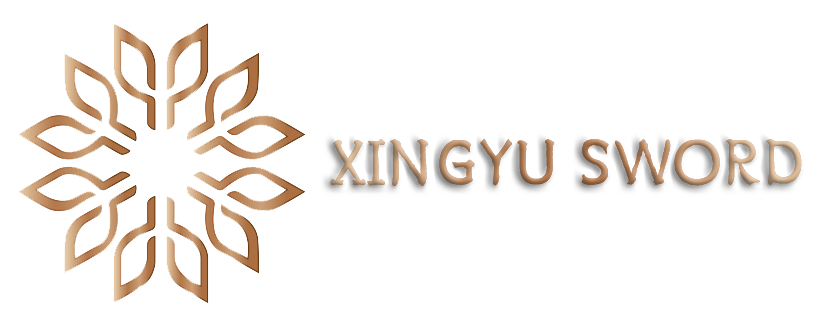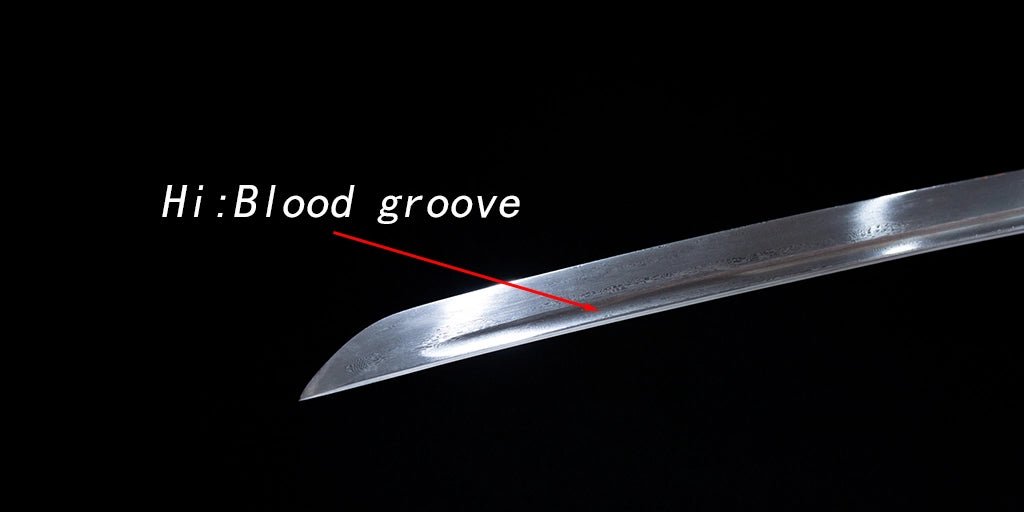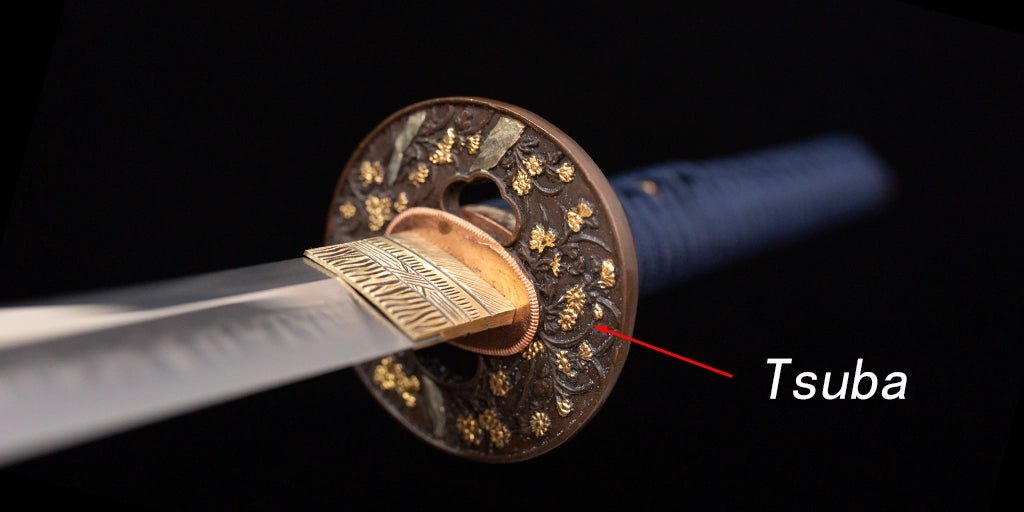

Horimono, a type of carving, often adds other decorative Horimono to the blade in addition to grooves. The properties of horimono are usually traditional images, such as swords, dragons, deities, Buddhist patterns, bonji, Chinese characters, and so on.Among the blades of the Koto period of sword manufacture (~1600), many of the carvings display religious meaning: Bonji (sanskrit), Su-ken, Fudo Myo-o,Kurikara, Sanko-tsuki-ken, Goma-bashi, Hachiman-daibosatsu, Namu-myoho-renge-kyo, and Sanjuban-shin.In the Shinto period of swordmaking (1600~), the carvings become more decorative with depictions of cranes and turtles, ascending and descending dragons, shochikubai (pine, bamboo and plum), and the deity of wealth, Daikoku.These images are carved with hammers hitting small chisels of various sizes. The internal surface of horimono is ground smoothly and finely, and polished during the polishing process. Making horimono is both difficult and time-consuming; Swordsmiths mostly carve grooves and simple Sanskrit characters themselves, while the more magnificent horimono is made by specialized craftsmen. After deciding which image to use, carefully draw a detailed pattern with a brush at the position to be carved, and then complete the horimono. The ideal horimono has a moderate proportion, the size matches the word to be carved, and is engraved in the appropriate position.

Draw a carved image on the blade - dragon
Draw the figure of a tiger using a curved board
Use a very fine chisel to carve the complete outline and details of a tiger
Use a hammer and chisel to deepen the lines and details of Horimono, starting from the tiger paws and claws in the front of the relief and carving down the way
The details of tiger claw are deeply carved into the cutting surface, and the internal lines and surface of Horimono must be very clean and flat
Carve out the details of the back palm
Horimono is not flat, but is embossed to appear on the surface of the blade. Here, the legs and head of this Horimono knife have already emerged.
All the details of Horimono are engraved below the surface of the blade
All internal surfaces of Horimono are polished with fine grinding stones
Use very fine chisels to carve the surface of Horimono to a flat surface, and the tips of these special chisels are personally shaped by craftsmen
The surface and contour of Horimono have been smoothed with a chisel
The surface of the tiger is trimmed with a small handheld chisel
The internal surface of Horimono is polished with a small strip of fine sandpaper, which is fixed and guided by a small synthetic stone
The internal surface is polished smooth, and Horimono is made into deep relief, with a very smooth three-dimensional surface
A vise for fixing the blade during carving. The surface is coated with a layer of pine resin and charcoal Hard black adhesive. Heat the black surface slightly with a gas gun, then press the sword down Up, so that the sword can be adjusted to any angle that is convenient for carving
Produce various hammers, chisels, and other tools for Horimono
Several chisels for carving. Chisels come in different sizes and have different tip shapes, with these tips being very thin
Other chisels used by Horimono have thicker tips
The tiger shaped Horimono on the new sword will be polished later
A dragon perched on the blade
Kaen Fudo, a Buddhist deity
Amida Nyorai, Buddhist deity
Fudo Myo-o,Kurikara and Sanko-tsuki-ken
If the surface of the blade is carved again, it should be done before quenching, because the blade is too hard after quenching. It is too high to be carved, and once the quenching fails, all the previous efforts will be wasted, so there is a carved knife with higher value. Some carvings are made by Japanese swordsmiths, and some are made by sculptors. Carving by the Japanese sword craftsman himself is called "joint carving", which shows the comprehensive skills of the knife craftsman. Diaglyph and haut-relief are used in carving, and the shapes are mainly Sanskrit, sword, dragon, Aryaacalanatha, plum blossom and bamboo, which are related to personal beliefs. Although Japanese sword is a weapon, its artistic requirements are no less than other works of art.
katana Bo-Hi
Why make Horimono? What is its purpose?
Bo-Hi is the earliest blade carving technique, its function is to change the weight of the blade, adjust the center of gravity of the blade, and make katana have a more perfect feel, and the cross-section of the blade after the Bo-Hi is a "工" shape, which can very effectively improve the strength of the blade.
Sanskrit grave
Afterwards, in order to have a higher level of improvement, the development of Horimono was promoted.At first, in times of war, it was almost impossible to avoid the fear of losing and dying, so the original meaning of the blade Horimono was to pray for blessings, and Buddhism prevailed in Japan in ancient times, and from the Heian period to the early Kamakura period, "Sanskrit" was engraved on the blade. Sanskrit was the simplest of the Horimono, but its symbolism provided the owner with a strong sense of confidence, and in the hands of the carver it was a very easy task to accomplish, and this kind of mutual benefit was maintained for a long time. But over time, the samurai were no longer satisfied with the simple "Sanskrit" and began to develop "Buddhist artifacts", the most familiar of which is the "Tokkosho". "Tokkosho", "Sankoken", "Gadā Vajra", which are mostly Acalanatha artifacts, and early The early "Buddhist artifacts" are still characterized by lines and not much detail, and the designs are still rather plain.

Sankoken Horimono
Guligaro dragon Horimono
When the war faded away and the carvers could start working in earnest, their skills improved and more complex designs appeared, such as Acalanatha, Guligaro (another form of Acalanatha), Manjushri, Samantabhadra and so on,
Manjushri, Samantabhadra, and so on. Acalanatha appears most frequently here, why Japan believes in Acalanatha so much, one is Acalanatha's powerful shape, with flames on his body, holding a sword in his hand with a very domineering look, is not to be messed with the character. Later on, the dragon form of Horimono took over half of the carvings, and is now the most common form of Horimono.Of course, there will be exceptions, some people who have Horimono on their blades simply to remember lost friends and family members
Dragon carving
There is a hierarchy of sculptors. A good carver, technology and attitude are indispensable, just have the technology, no attitude can not do good things, of course, the attitude to the, no technology to support that can only be Follow the cat and draw the tiger.
Carved Guligaro Dragon


































Leave a comment
This site is protected by hCaptcha and the hCaptcha Privacy Policy and Terms of Service apply.